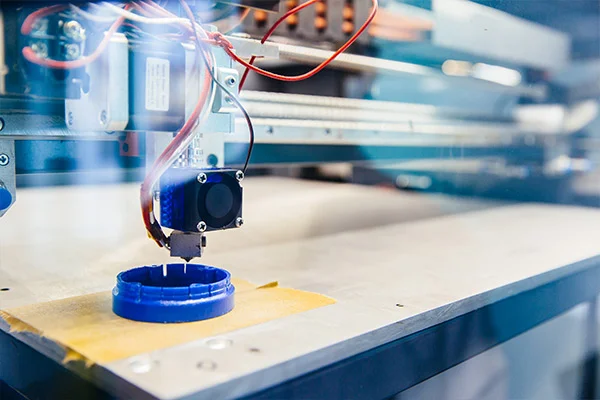Additive Manufacturing: The past and the prominence of 3D Printing
Additive Manufacturing is one of the most significant reforms in a fast-changing world of manufacturing and construction. Additive manufacturing has triggered newer processes, sustainable output, smart machines, and more unique means of operation, management, and increased efficiency. Additive manufacturing is a computer-operated and controlled system that creates three-dimensional objects by carefully sequentially depositing various material compositions in layers. A comprehensive digital layout is fed as design data, and the machine operates accordingly. Additive manufacturing is mainly used for making rapid prototypes and forging complex geometric objects. The other names for Additive Manufacturing are 3D printing, Additive Layer Manufacturing. The technology has gained worldwide prominence with the name of 3D printing. FAQ Commercialization of 3D printers 3D printing is not an archaic process, but rather, it came up in the ’80s. Here is a summary of the history of 3D printers in the last four decades: The 80’s witnessed the first commercial use of additive manufacturing with stereolithography from 3D Systems. The SLA-1 was the first commercially released AM machine. Acrylate resins were commercialized. The Somos stereolithography machine also entered the market in the same year. In the ’90s, Germany’s Electro-Optical Systems sells the first stereolithography system. Fused deposition modeling (FDM), solid ground curing (SGC), and laminated object manufacturing (LOM) were commercialized. Selective laser sintering (SLS) and Soliform stereolithography system were also commercialized. This year saw a bunch of new additives manufacturing systems such as ModelMaker, Solid Center, or EOSINT. An inkjet printing mechanism that deposited wax materials layer by layer was also introduced. The late 2000s saw a rapid growth of the 3D printing machine market. The 3D printing Industry witnessed massive investment 2000’s saw the emergence of new technologies. The world got its first commercially available multi-color 3D printer. The Electron Beam melting machine was one of the groundbreaking 3D printing machines introduced in the early 2000s. In March 2015, Exerial was introduced, a large machine with multiple stations to enable continuous production. Early 3D printers were not very light and convenient to handle. Only after the advent of the 21st century have they become more affordable, straightforward, easy to operate, and versatile enough to be used in a wide range of operations ranging from tools & component manufacture, electronics, metalwork, polymers, etc., product prototypes. Past three years, there has been a tendency to employ 3D printing and AM tech in the real estate industry. Current 3D Printing market trends The worldwide 3D printing products and services market valued at around 12.6 billion U.S. dollars in 2020. The industry is expected to grow at a compound annual growth rate of some 17 percent between 2020 and 2023. As more businesses begin to have their printers, printing software will grow faster than printing services. We can see how fast Additive manufacturing emerged within just three decades and how it is relevant across multiple industrial verticals today. Whether it is about building prototypes, constructing affordable housing, or producing components, AM and 3D printing have offered effective systems that triumph over traditional methods. This technology enables faster product development and market entry, smoother product customization, and seamless integration at lesser cost and time. Thus, additive manufacturing provides OEM manufacturers an excellent opportunity to unleash their products at a higher rate at much lesser expenses for great returns and better customer benefits while ensuring sustainability. Reference: 1. Wohlers, T. and Gornet, T., (2016). History of additive manufacturing, Wohlers Report 2016. 2. Global 3D printing products and services market size from 2020 to 2026, Statista
Read MoreReverse Engineering: Outsourcing and Beyond
FAQs Points to keep in mind while outsourcing reverse engineering services Choosing a Vendor all know reverse engineering is an economical approach towards product development & innovation, which manufacturers often utilize to evaluate and redesign competitor products. Reverse Engineering services involve understanding the product design, system integrity, and manufacturing processes involved to realize the potential required to build a similar or improved product version. The reverse engineering technique is best suitable for producing design data and related technical manuals for products that no longer have any design information. The entire work process involves engineers studying every design feature, associated manufacturing processes, and tools needed for product development and storing information. After digitizing the complete information, suitable design modifications are carried out as per requirements. However, to get things right, one should have an efficient and dedicated engineering team, the right software, hardware tools, etc., which seems difficult to have within the organization. FAQs Here comes the advantage of outsourcing reverse engineering projects where the activities can significantly reduce the cost of product development and burden the engineers who can focus on developing innovative design solutions for the product.Reverse engineering services outsourcing might invoke some hesitancy. To address it, here are some of the crucial benefits of outsourcing reverse engineering projects: Still have more questions, ask us Prescient Technology’s reverse engineering expertise has helped companies meet their designing and innovative demands. If you wish to know more, just click the button below. Points to keep in mind while outsourcing reverse engineering services As feasible as reverse engineering outsourcing sounds, there are specific steps to follow and factors to consider. Few crucial points to discuss when outsourcing reverse engineering services are as follows: Choosing a Vendor After finalizing the decision to outsource reverse engineering service, the next vital step to consider is choosing a vendor. A responsive and efficient vendor makes all the difference. Finding a professional vendor with a high level of efficiency and even heightened work ethic is a complex but satisfying process. Be aware that once you are engaged with a vendor, it becomes a little difficult to break the deal and discontinue ‘business’ with the existing vendor. So choose carefully but commit completely after the contract.When a vendor has been finalized, the organization issues a request for quotation (RFQ). RFQs are created to invite suppliers to a bidding process to bid on specific services/products. The organization should also take a legal approach and have the service provider’s non-disclosure agreement (NDA). This is done to prevent unlawful, authorized distribution, or illicit product adoption.Now that the legal approach and paperwork have been taken care of, the organization sends the physical product to the service provider or the scanned files, depending on the company’s needs. The vendor is also supplied with measurement specifications and related industry standards to follow. Eventually, the vendor creates a digital format and sends it back to the organization for further design modification or innovation investigations.For manufacturers, reverse engineering is a profitable strategy in today’s competitive scenario; however, outsourcing brings along the other benefits that ensure the product development process remains cost-effective. Prescient Technologies is adept at providing outstanding reverse engineering services and has extensive experience in the end-to-end process, so feel free to contact us today.
Read More
